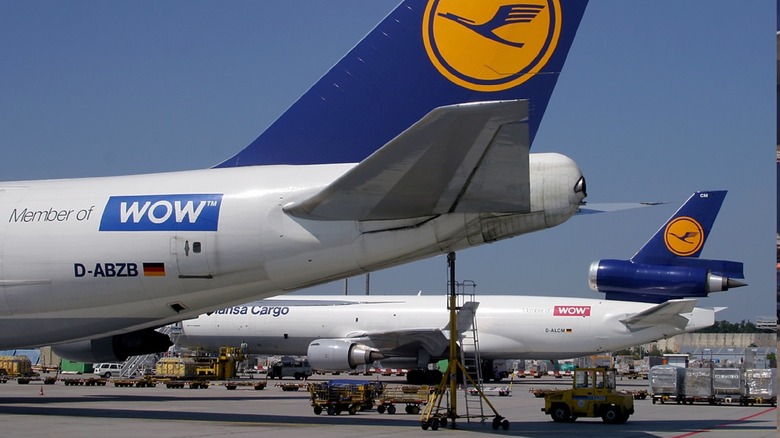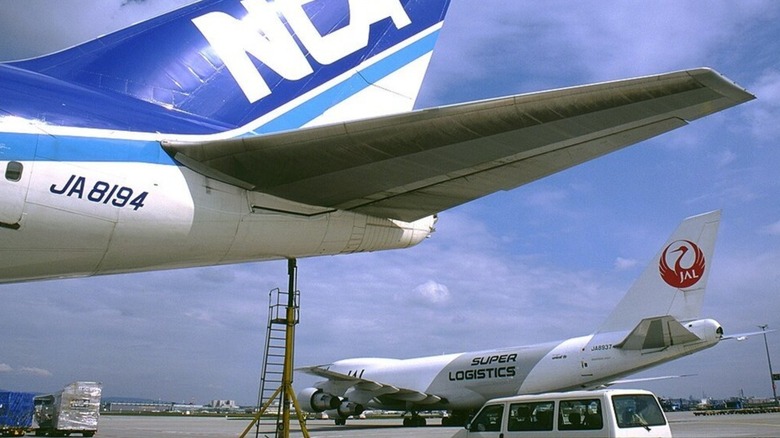
What if we told you that some Boeing planes can lift their nose without anyone touching the yoke -- oh, and this can happen while the plane is parked at the gate? It's a very real phenomenon called tail tipping. Unlike debates over yokes versus side sticks, this has nothing to do with pilot input.
The whole thing boils down to playground physics. An airplane on the ground is a giant seesaw balancing on its main landing gear. For everything to stay level, the center of gravity needs to stay forward
of this pivot point, but it moves as people and cargo are unloaded. On some planes, particularly longer or stretched models like the Boeing 737-900 series, the margin for error is surprisingly slim due to design choices Boeing has made.
To be clear, this is not the same as a tail strike, which happens when a pilot may take an aggressive angle of attack on takeoff and scrapes the plane's derriere on the runway. Tail tipping is a static, slow-motion screwup that happens when the plane is stationary. To prevent these graceful giants from unexpectedly tilting back, ground crews employ a surprisingly low-tech solution -- a tail stand. Often called a pogo stick, it's a sturdy pole placed under the aft fuselage that acts as a kickstand, physically preventing the tail from dropping. For aircraft like the 737-900ER, this isn't just a good idea -- it's often standard operating procedure.
Read more: These Are The Best Engines Of All Time, According To You
The Kicker For The Kickstand

The kickstand isn't just a good idea -- it's the final, physical defense in a multi-layered system designed to manage a known design characteristic. For years, the responsibility for this system fell in a bit of a gray area of who was responsible for bringing the equipment into play. Starting in 2019, the Federal Aviation Administration has told airlines it is their direct responsibility -- no more finger-pointing allowed.
This meticulous ground choreography is just an example of the highly specific procedures crews must master for these workhorse aircraft. The 737 family's long history has led to a host of unique characteristics that might seem counterintuitive, including the reasons why you can't use a Boeing 737's rear exits in a water landing.
Recognizing that gaps can exist in interpretation, European regulators are now taking a more direct approach. The European Union Aviation Safety Agency has rolled out new regulations that make ground handling companies formally and directly accountable for safety. The agency even specifically calls out aircraft tail tipping as a key risk to be managed by ground crews. This move from guidance to direct regulation shows a growing acknowledgment that as aircraft designs are pushed to their limits, the procedural safeguards meant to keep them safe need more rigorous oversight.
Since We Know About It, It Can't Happen — Right?
So, what happens when the procedures aren't followed, or the humble tail stand is missing in action? Simply put, gravity happens. As it turns out, physics does not care about flight schedules. A couple of high-profile incidents, specifically with the Boeing 737-900ER, show just how easily things can go wrong.
In 2018, a Ukraine International Airlines 737-900ER fell victim to a perfect storm when crews unloaded the front cargo first but the conveyor for the rear cargo broke. As passengers departed their seats, the plane tipped. Another example occurred in 2021, when a United Airlines 737-900ER carrying the University of Southern California football team tipped over at a regional airport in Idaho. United, one of the U.S. airlines with the largest Boeing fleets, knows these procedures well, but the smaller Idaho airport reportedly didn't have the required tail stand. As staff and equipment were unloaded, the plane pivoted backward onto its tail.
These incidents highlight that the safety system is a chain, and a single broken link -- be it a broken conveyor belt or a missing piece of ground equipment -- can bring the whole thing down. Or, in this case, pointing up.
Want more like this? Join the Jalopnik newsletter to get the latest auto news sent straight to your inbox...
Read the original article on Jalopnik.













